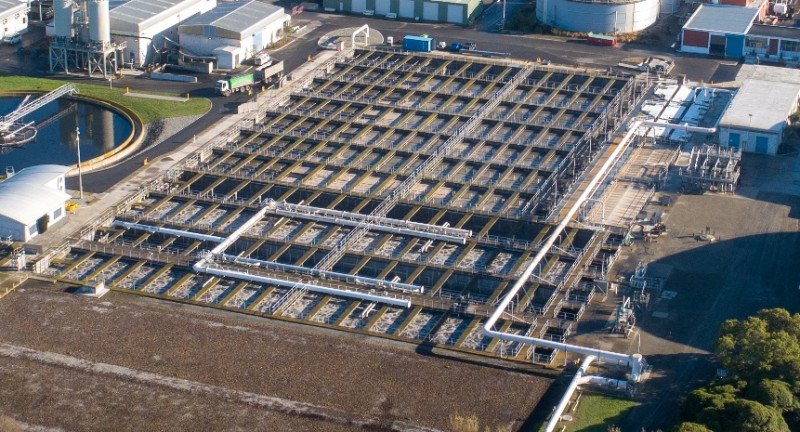The Christchurch wastewater treatment plant processes the wastewater from all of Christchurch city and from Whakaraupō/Lyttelton Harbour.

There are 239 pump stations, lift stations and vacuum stations located throughout Christchurch.
Five terminal pump stations pump all the flow to the treatment plant.
All stations are connected by radio to a main control room and monitored by the team at the Christchurch Wastewater Treatment Plant.
Browse the Network Map(external link) for detail on how these pump stations are connected.
As wastewater flows into the plant, screens catch the rags and tanks then trap the grit before the flow goes into the sedimentation tanks.
The rags and grit are removed and disposed of at the Kate Valley Landfill. About two tonnes of rag and two tonnes of grit are removed every day.
The wastewater then passes through primary sedimentation tanks. Heavy organic matter settles to the bottom of the primary sedimentation tanks, which is then scraped to one end and pumped to the digesters for treatment.

Primary sedimentation tanks
The liquid left at the end of the primary sedimentation tanks is pumped into the bottom of the solid contact tanks. Air is then injected into this liquid in fine bubbles, which provides air to the activated sludge to break down any organic matter.
This liquid is then pumped into the next step, which is aeration basins equipped with aerators. These aerators help make up for the treatment capacity which was lost with the fire that broke out in the trickling filters in November 2021.
The solids are sucked off the bottom of the clarifier tanks leaving a clear liquid which then flows out to the oxidation ponds.

Clarifiers on left and Aeration Basins on right
There are six maturation ponds, and it takes about 16 days for the clear liquid from the clarifiers to flow through the oxidation ponds.
Sunlight and natural processes kill the harmful bacteria and viruses without the need for additional chemicals or artificial UV light.
The treated wastewater from the maturation ponds is discharged through a long outfall pipe which discharges three kilometres off New Brighton beach.
The total outfall pipe length from the maturation ponds is 5.2 kilometres and it is 1.8 metres in diameter. It is buried about eight metres below the sea floor.

Maturation/oxidation ponds
The sludge that was scraped from the bottom of the primary sedimentation tanks and from the clarifiers is pumped to the digesters for treatment.
During this treatment process helpful bacteria break down the sludge to form biosolids. This process produces a mixture of methane gas and carbon dioxide which is called biogas.
The biosolids at this stage are very wet – 98% water and only 2% solids. To remove the water, the biosolids are passed through a machine that squeezes the water out, then they are pumped into a biosolids dryer. The biosolids dryer uses hot air to evaporate the water and kill pathogens (bacteria and viruses). The treated biosolids now look like coarse dry sand.
The dry biosolids are then stored ready to be transported to land remediation projects for beneficial reuse as a soil conditioner and fertiliser.

The biogas produced during the digester treatment process is used to power our gas engines.
The engines generate electricity for the treatment plant and hot water to warm the liquid in the digesters to the optimum temperature for sludge digestion.
Any odour or ‘foul air’ produced at the treatment plant is passed through large bark biofilters.
The bark absorbs the odour and ‘helpful’ bacteria break down the odorous compounds to leave fresh air.
Our environmental statement [PDF, 342 KB] is about our commitment to providing the community with a safe and healthy environment through appropriate treatment and disposal of wastewater.
Being a responsible Council means understanding that our activities have environmental impacts, both positive and negative.
As operators of the largest wastewater treatment plant on the South Island, we are well aware of our responsibilities to protect and enhance our environment, now and into the future.
We will:
- Manage our water, land and renewable energy resources more sustainably and promote their efficient use.
- Commit to minimising pollution resulting from our operations and improving water quality through our operations.
- Protect and enhance the natural environment and the services it provides.
- Manage our use of natural resources, work to minimise waste and put it to valuable uses.
- Aim to fulfil legal and regulatory requirements.
- Integrate environmentally responsible behaviour in our business operations.
We will do this by:
- Establishing, implementing, maintaining and continually improving an Environmental Management System that is compliant with the ISO14001:2015 standard.
- Monitoring our environmental performance in order to meet, manage and review compliance obligations, programmes, environmental objectives and other targets.
- Designing, operating and maintaining our assets base to the applicable environmental standards.
- Investing in the learning and development of our employees – enabling them to maintain competence to deliver environmental improvements.
- Managing our water, land and renewable energy responsibly in terms of water quality, waste reduction, biodiversity, heritage, access and recreation.
- Investigating and, where appropriate, integrating new technologies and practices into existing systems in order to drive environmental improvement.
- Working with our suppliers to set and achieve appropriate environmental goals.
- Engaging with all relevant stakeholders to help shape our environmental decision-making.
